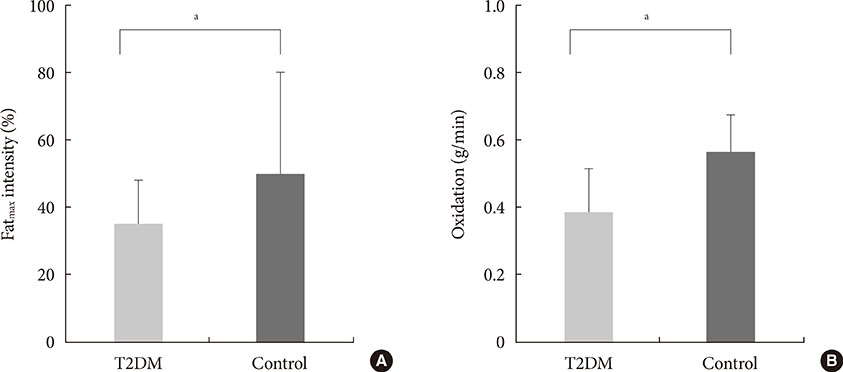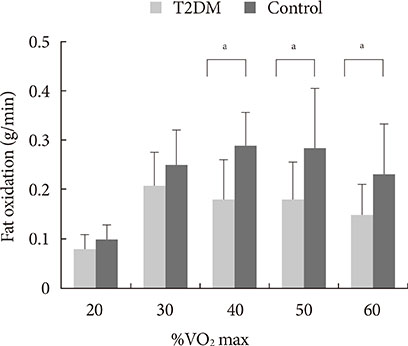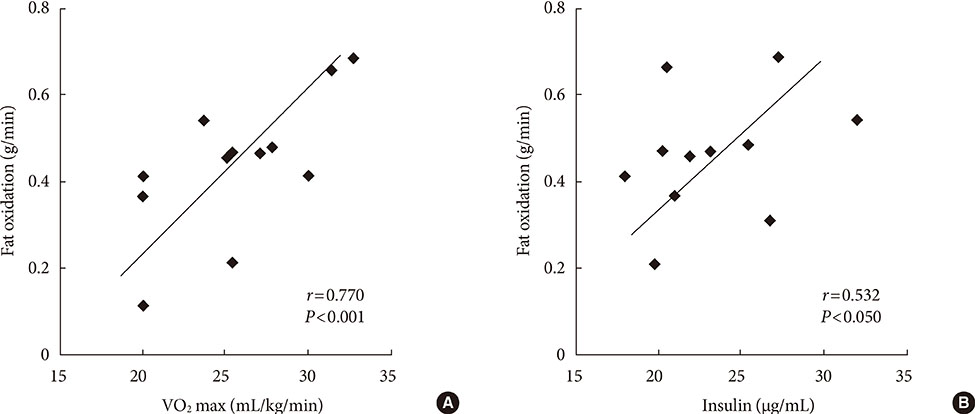Diabetes Metab J.
2015 Aug;39(4):328-334. 10.4093/dmj.2015.39.4.328.
Maximal Fat Oxidation Rate during Exercise in Korean Women with Type 2 Diabetes Mellitus
- Affiliations
-
- 1Department of Kinesiology and Medical Science, Dankook University College of Medicine, Cheonan, Korea. shinagel@dankook.ac.kr
- 2Diabetes Center, Department of Internal Medicine, Kangbuk Samsung Hospital, Sungkyunkwan University School of Medicine, Seoul, Korea.
- 3Division of Endocrinology and Metabolism, Department of Internal Medicine, Kangbuk Samsung Hospital, Sungkyunkwan University School of Medicine, Seoul, Korea. cydoctor@chol.com
- KMID: 2174029
- DOI: http://doi.org/10.4093/dmj.2015.39.4.328
Abstract
- BACKGROUND
The purpose of this study was to determine the appropriate exercise intensity associated with maximum fat oxidation, improvement of body composition, and metabolic status in Korean women with type 2 diabetes mellitus (T2DM).
METHODS
The study included a T2DM group (12 women) and a control group (12 women). The groups were matched in age and body mass index. The subjects performed a graded exercise test on a cycle ergometer to measure their maximal fat oxidation (Fatmax). We also measured their body composition, metabolic profiles, and mitochondrial DNA (mtDNA).
RESULTS
The exercise intensity for Fatmax was significantly lower in the T2DM group (34.19% maximal oxygen uptake [VO2 max]) than the control group (51.80% VO2 max). Additionally, the rate of fat oxidation during exercise (P<0.05) and mtDNA (P<0.05) were significantly lower in the T2DM group than the control group. The VO2 max level (P<0.001) and the insulin level (P<0.05) were positively correlated with the rate of fat oxidation.
CONCLUSION
The results of this study suggest lower exercise intensity that achieves Fatmax is recommended for improving fat oxidation and enhancing fitness levels in Korean women with T2DM. Our data could be useful when considering an exercise regimen to improve health and fitness.
Keyword
MeSH Terms
Figure
Reference
-
1. Ghanassia E, Brun JF, Fedou C, Raynaud E, Mercier J. Substrate oxidation during exercise: type 2 diabetes is associated with a decrease in lipid oxidation and an earlier shift towards carbohydrate utilization. Diabetes Metab. 2006; 32:604–610.2. Perez-Martin A, Dumortier M, Raynaud E, Brun JF, Fedou C, Bringer J, Mercier J. Balance of substrate oxidation during submaximal exercise in lean and obese people. Diabetes Metab. 2001; 27(4 Pt 1):466–474.3. Sardinoux M, Brun JF, Lefebvre P, Bringer J, Fabre G, Salsano V, Fabre JM, Nocca D. Influence of bariatric surgery on exercice maximal lipid oxydation point in grade 3 obese patients. Fundam Clin Pharmacol. 2009; 23:Suppl 1. 57.4. Brun JF, Malatesta D, Sartorio A. Maximal lipid oxidation during exercise: a target for individualizing endurance training in obesity and diabetes? J Endocrinol Invest. 2012; 35:686–691.5. Sahlin K, Sallstedt EK, Bishop D, Tonkonogi M. Turning down lipid oxidation during heavy exercise: what is the mechanism? J Physiol Pharmacol. 2008; 59:Suppl 7. 19–30.6. Friedlander AL, Casazza GA, Horning MA, Buddinger TF, Brooks GA. Effects of exercise intensity and training on lipid metabolism in young women. Am J Physiol. 1998; 275(5 Pt 1):E853–E863.7. Kelley DE, Goodpaster B, Wing RR, Simoneau JA. Skeletal muscle fatty acid metabolism in association with insulin resistance, obesity, and weight loss. Am J Physiol. 1999; 277(6 Pt 1):E1130–E1141.8. Van Aggel-Leijssen DP, Saris WH, Hul GB, Van Baak MA. Long-term effects of low-intensity exercise training on fat metabolism in weight-reduced obese men. Metabolism. 2002; 51:1003–1010.9. Mogensen M, Vind BF, Hojlund K, Beck-Nielsen H, Sahlin K. Maximal lipid oxidation in patients with type 2 diabetes is normal and shows an adequate increase in response to aerobic training. Diabetes Obes Metab. 2009; 11:874–883.10. Metz L, Sirvent P, Py G, Brun JF, Fedou C, Raynaud E, Mercier J. Relationship between blood lactate concentration and substrate utilization during exercise in type 2 diabetic postmenopausal women. Metabolism. 2005; 54:1102–1107.11. Cheneviere X, Borrani F, Droz D, Gojanovic B, Malatesta D. Effects of 2 different prior endurance exercises on whole-body fat oxidation kinetics: light vs. heavy exercise. Appl Physiol Nutr Metab. 2012; 37:955–964.12. Larsen S, Ara I, Rabol R, Andersen JL, Boushel R, Dela F, Helge JW. Are substrate use during exercise and mitochondrial respiratory capacity decreased in arm and leg muscle in type 2 diabetes? Diabetologia. 2009; 52:1400–1408.13. Achten J, Gleeson M, Jeukendrup AE. Determination of the exercise intensity that elicits maximal fat oxidation. Med Sci Sports Exerc. 2002; 34:92–97.14. Takagi S, Sakamoto S, Midorikawa T, Konishi M, Katsumura T. Determination of the exercise intensity that elicits maximal fat oxidation in short-time testing. J Sports Sci. 2014; 32:175–182.15. World Health Organization. Definition, diagnosis and classification of diabetes mellitus and its complications report of a WHO consultation: part 1: diagnosis and classification of diabetes mellitus. Geneva: World Health Organization;1999.16. Brandou F, Dumortier M, Garandeau P, Mercier J, Brun JF. Effects of a two-month rehabilitation program on substrate utilization during exercise in obese adolescents. Diabetes Metab. 2003; 29:20–27.17. Wasserman K, Beaver WL, Whipp BJ. Mechanisms and patterns of blood lactate increase during exercise in man. Med Sci Sports Exerc. 1986; 18:344–352.18. Simoneau JA, Kelley DE. Altered glycolytic and oxidative capacities of skeletal muscle contribute to insulin resistance in NIDDM. J Appl Physiol (1985). 1997; 83:166–171.19. Brun JF, Jean E, Ghanassia E, Flavier S, Mercier J. Metabolic training: new paradigms of exercise training for metabolic diseases with exercise calorimetry targeting individuals. Ann Readapt Med Phys. 2007; 50:528–534.20. Frayn KN. Calculation of substrate oxidation rates in vivo from gaseous exchange. J Appl Physiol Respir Environ Exerc Physiol. 1983; 55:628–634.21. Friedewald WT, Levy RI, Fredrickson DS. Estimation of the concentration of low-density lipoprotein cholesterol in plasma, without use of the preparative ultracentrifuge. Clin Chem. 1972; 18:499–502.22. Matthews DR, Hosker JP, Rudenski AS, Naylor BA, Treacher DF, Turner RC. Homeostasis model assessment: insulin resistance and beta-cell function from fasting plasma glucose and insulin concentrations in man. Diabetologia. 1985; 28:412–419.23. Toledo FG, Menshikova EV, Ritov VB, Azuma K, Radikova Z, DeLany J, Kelley DE. Effects of physical activity and weight loss on skeletal muscle mitochondria and relationship with glucose control in type 2 diabetes. Diabetes. 2007; 56:2142–2147.24. Dumortier M, Brandou F, Perez-Martin A, Fedou C, Mercier J, Brun JF. Low intensity endurance exercise targeted for lipid oxidation improves body composition and insulin sensitivity in patients with the metabolic syndrome. Diabetes Metab. 2003; 29:509–518.25. Mendelson M, Jinwala K, Wuyam B, Levy P, Flore P. Can crossover and maximal fat oxidation rate points be used equally for ergocycling and walking/running on a track? Diabetes Metab. 2012; 38:264–270.26. Snowling NJ, Hopkins WG. Effects of different modes of exercise training on glucose control and risk factors for complications in type 2 diabetic patients: a meta-analysis. Diabetes Care. 2006; 29:2518–2527.27. Lazzer S, Busti C, Agosti F, De Col A, Pozzo R, Sartorio A. Optimizing fat oxidation through exercise in severely obese Caucasian adolescents. Clin Endocrinol (Oxf). 2007; 67:582–588.28. Riddell MC, Jamnik VK, Iscoe KE, Timmons BW, Gledhill N. Fat oxidation rate and the exercise intensity that elicits maximal fat oxidation decreases with pubertal status in young male subjects. J Appl Physiol (1985). 2008; 105:742–748.29. Bordenave S, Metz L, Flavier S, Lambert K, Ghanassia E, Dupuy AM, Michel F, Puech-Cathala AM, Raynaud E, Brun JF, Mercier J. Training-induced improvement in lipid oxidation in type 2 diabetes mellitus is related to alterations in muscle mitochondrial activity. Effect of endurance training in type 2 diabetes. Diabetes Metab. 2008; 34:162–168.30. Kelley DE, He J, Menshikova EV, Ritov VB. Dysfunction of mitochondria in human skeletal muscle in type 2 diabetes. Diabetes. 2002; 51:2944–2950.31. Mogensen M, Sahlin K, Fernstrom M, Glintborg D, Vind BF, Beck-Nielsen H, Hojlund K. Mitochondrial respiration is decreased in skeletal muscle of patients with type 2 diabetes. Diabetes. 2007; 56:1592–1599.32. Kelley DE, Simoneau JA. Impaired free fatty acid utilization by skeletal muscle in non-insulin-dependent diabetes mellitus. J Clin Invest. 1994; 94:2349–2356.33. Boushel R, Gnaiger E, Schjerling P, Skovbro M, Kraunsoe R, Dela F. Patients with type 2 diabetes have normal mitochondrial function in skeletal muscle. Diabetologia. 2007; 50:790–796.34. Martin IK, Katz A, Wahren J. Splanchnic and muscle metabolism during exercise in NIDDM patients. Am J Physiol. 1995; 269(3 Pt 1):E583–E590.35. Bruce CR, Thrush AB, Mertz VA, Bezaire V, Chabowski A, Heigenhauser GJ, Dyck DJ. Endurance training in obese humans improves glucose tolerance and mitochondrial fatty acid oxidation and alters muscle lipid content. Am J Physiol Endocrinol Metab. 2006; 291:E99–E107.36. Hordern MD, Marwick TH, Wood P, Cooney LM, Prins JB, Coombes JS. Acute response of blood glucose to short-term exercise training in patients with type 2 diabetes. J Sci Med Sport. 2011; 14:238–242.37. Mohebbi H, Azizi M. Maximal fat oxidation at the different exercise intensity in obese and normal weight man in the morning and evening. J Hum Sport Exerc. 2011; 6:49–58.38. Manetta J, Brun JF, Perez-Martin A, Callis A, Prefaut C, Mercier J. Fuel oxidation during exercise in middle-aged men: role of training and glucose disposal. Med Sci Sports Exerc. 2002; 34:423–429.39. Zakrzewski JK, Tolfrey K. Acute effect of Fatmax exercise on the metabolism in overweight and nonoverweight girls. Med Sci Sports Exerc. 2012; 44:1698–1705.
- Full Text Links
- Actions
-
Cited
- CITED
-
- Close
- Share
- Similar articles
-
- The Effects of Aerobic/Resistance Exercise on Body Fat Mass, Muscle Strength and Endothelial Function in Korean Type 2 Diabetes mellitus Patients
- Exercise Performance Test Using Bicycle Ergometer in Patients with Diabetes Mellitus
- Maximal Muscle Strength Deteriorates with Age in Subjects with Type 2 Diabetes Mellitus
- Study on Multistage Maximal Stress Exercise Test
- Arterial Stiffness by Aerobic Exercise Is Related with Aerobic Capacity, Physical Activity Energy Expenditure and Total Fat but not with Insulin Sensitivity in Obese Female Patients with Type 2 Diabetes




